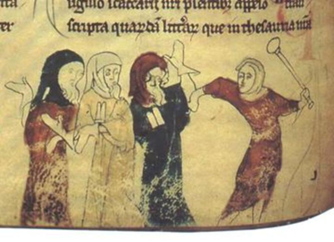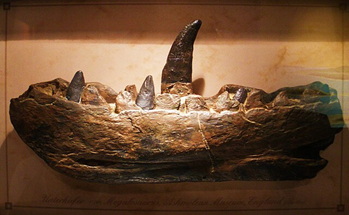The first Jewish settlements in the United Kingdom
Before the Norman Conquest of 1066, Jewish people lived in England, but not as part of organised communities. The first Jewish settlement of 1070 was comprised of Jewish financiers from Rouen, in the northern region of France, who were invited in by William the Conqueror (William I) to establish themselves in England and Wales in the hopes that they could prop up the administration of his government and consolidate his position as the King of England.
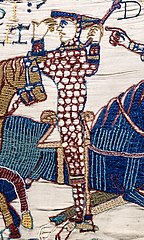
William the Conqueror depicted in the Bayeux Tapestry, Wikipedia
In order to achieve this William I was required to borrow large sums of money. However, he was impeded by Catholic doctrine, which considered lending money for interest, also known as usury, a sin, forbidding Christians from participating in the practice. As Judaism permits loans with interest between Jews and non-Jews, this obstacle was circumvented, and Jewish people were encouraged and sometimes forced to engage in this practice. Once they arrived in England and Wales, Jewish people became the collective property of the Crown, and, while they were granted a Charter of Liberties which meant that they could rely on the Crown for protection, they were also taxed onerously. The privilege to lend money at interest was exploited by English rulers and, although business dealings prospered between Jews and Christians, as the former grew wealthier, the Jewish community became more and more relied upon as a source of funds, not only for the monarchy, but also for the wider Christian population. Increasing amounts of debt to Jewish creditors, alongside the perceived image of Jews as being on the side of rulers, stoked the growing antisemitic sentiment plaguing Europe at the time. This was also propagated by the beginning of the Crusades in 1096 and fabricated allegations of Jews taking part in a ritual called ‘blood libel’, which involved the abduction and sacrifice of Christian children. The Crown did not protect the Jewish community from persecution and supposedly sometimes conflict was even encouraged by rulers such as William II (William Rufus), the son and successor of William I, who would orchestrate public debates on theological topics between the two parties. All of this came to a head on the coronation of King Richard I in September of 1189, when many Christian and Jewish subjects alike came to Westminster Abbey in London to pay homage to their new ruler. However, Christian holding religious superstitions regarding the presence of Jews at the holy event, flogged them and threw them out of the coronation banquet. After this incident, rumour spread like wildfire throughout England that the king had ordered the murder of Jews, which led to multiple instances of mob-led anti-Jewish violence in London, East Anglia, Lincolnshire and York. Indeed, it was in York that the bloodiest pogrom took place on the 16th and 17th of March, 1190, where 150 Jews were massacred, which completely eradicated the local Jewish community. What set this particular attack apart from the rest is that it was led by the noblemen Richard Malebisse, William Percy, Marmaduke Darell, and Philip de Fauconberg, who took advantage of growing anti-semitic sentiment to erase large amounts of debt accrued from Jewish moneylenders. It was this attack that prompted King Richard I to develop a new system where records of loans were to be kept in archae (chests) in each Jewish settlement, to avoid record destruction.
The Expulsion of Jews of 1290
Subsequent rulers, such as King John (1199-1216) forced the Jewish community to pay ever increasing amounts of money as taxes. In 1210, as a result of his debt accrued from a failed campaign against France, he summoned Jewish leaders from across England to Bristol, where they were imprisoned and tortured, because he believed that they had concealed their assets from him in 1207. They were threatened with continued imprisonment, torture and expulsion if they did not pay him 66,000 marks (approximately the equivalent of £1,000,000 today). They were unable to pay this sum, which resulted in many arrests and jail sentences. In 1215, King John signed the Magna Carta, which contained two clauses pertaining to Jewish moneylending:
‘10. If anyone has taken a loan from Jews, great or small, and dies before the debt is paid, the debt is not to incur interest for as long as the heir is under age, whoever he may hold from. And if the debt comes into our hands, we will take only the principal recorded in the charter.
11. And if anyone dies, and owes a debt to Jews, his wife is to have her dower and pay nothing towards that debt. And if there are surviving children of the deceased who are under age, their needs are to be provided for them in proportion to the dead man’s tenement, and the debt is to be paid from the residue, saving the service owed to the lords. Debts owed to others besides Jews are to be dealt with in like manner’.
These two clauses attempted to limit Jewish lenders and the king’s power over the estates of Christian debtors, many of whom were the barons that had earlier in the year taken up arms and rebelled against him and which forced King John to submit to their demands. These were repealed only a year later by his son King Henry III (1216-72), who extracted larger and larger sums of money from the Jewish communities via taxation and forced ‘gifts’. In order to afford this, Jewish lenders would often sell on their debts and then the new owners of the debt would pressure debtors to pay up. Curbing Jewish lending became such a great issue, that parliament demanded for measures to be taken from the 1260s onwards.
While there were no massacres in Oxford, like in other major cities, the Jewish community of Oxford was imprisoned on the 17th May 1268 on Ascension Day for desecrating the processional cross. They were forced to inscribe their ‘misdeed’ upon a marble and gold cross that they paid for, which was erected on the opposite of the synagogue, near what is now the modern day north corner of Christ Church College. The embellished base of the cross can be seen at the Museum of Oxford.
Henry’s son, King Edward I established the Statute of the Jewry of 1275, which placed strict regulations upon the Jewish community. This included outlawing the practice of usury altogether, restricting Jewish living to specific areas of towns, forcing Jewish people over 7 to identify themselves by wearing the double tabula badge (though this varies, for example, the Council of Oxford required a yellow star), taxing those above 12 years of age 3 pence every Easter, and requiring the king’s permission to sell property or negotiate debts. Since Jewish people could not own farmland nor could they join guilds (groups of craftsmen), many Jews became impoverished and when they could no longer pay their taxes, they were executed or imprisoned. By 1290, Edward was under pressure due to debt accrued as a result of his war with France. He was only able to acquire parliament’s permission to raise tax for funds by sacrificing the remaining Jewish population in England.
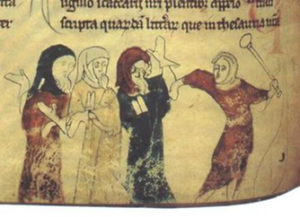
The expulsion of the Jews, marginal illustration from the Rochester Chronicles, Wikipedia
On 18th July in the same year, Edward issued the Edict of Expulsion, in which Jews had until 1st November to leave, lest they were subject to be seized and executed. They were only allowed to take with them all that they could carry, with any property being forfeited to the crown. Around 3,000 Jewish people forcefully left England to settle mostly in France and Germany, while those who remained hid their faith. Edward was granted the single largest tax of the Middle Ages – £116,000 by the Parliament.
The readmission of Jews by Oliver Cromwell
Jewish people remained banned from England for 366 years until the 17th century. It should be noted however, that there were subsequent small settlements of Jewish traders in the 16th and 17th centuries in Bristol and London, following the expulsions of Jews from Spain via the Alhambra Decree and similar measures in Portugal. They were referred to as Marranos and presented themselves as Christians or newly converted Christians but practiced Judaism in secret. They largely evaded negative attention from others by outwardly observing Christian customs and abstaining from public displays of their faith of origin. As London increasingly grew in importance as a hub of trade, the Jewish community also gained in numbers.
During this period, there was a movement towards religious tolerance in general and a push for the official recognition of the right of every citizen to practice their own religion, mostly pertaining to Nonconformists. At the same time, Protestant and Catholic Reformations were changing European Christianity, with old ideas around the meaning of being a Christian being revisited. It became imperative to understand and study the foundations of Christianity, especially for those with leadership positions within the church. As a result, engagement with the word of God in its original language, Hebrew, was encouraged, with special attention paid to the Old Testament, for which Jewish scholars needed to be brought in. Also present in Protestant doctrine at the time was the belief that in order for Christ to return to rule on Earth, all Jews needed to be converted to Christianity. This group of people were also known as Millenarian ‘admissionists’. One such person, Leonard Busher printed in 1614 the Religious Peace; or, a Plea for Liberty of Conscience, long since presented to King James and the High Court of Parliament then sitting and was one of the first to advocate for the religious tolerance and resettlement of Jewish people with the hope that they would eventually be converted. Oliver Cromwell himself, Lord Protector, held many of the beliefs that millenarians did, but also sought to strengthen London’s trade by creating links to the Jewish traders of Amsterdam.
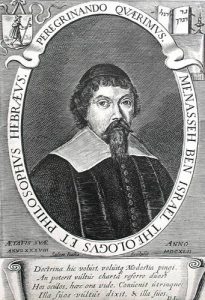
Menasseh ben Isreal, Wikepedia
It is for these reasons that when Menasseh ben Israel, respected Jewish rabbi, scholar, and printer settled in Amsterdam, appealed to Cromwell for the readmission of Jewish people back into England, a national conference was held at Whitehall on December 4, 1655. While initially met with resistance, in 1656 an unofficial readmission was authorised via Cromwell, who made a verbal promise (supported by the Council of State) to allow the return of Jewish people to England, free to practice their faith.
England’s first coffeehouse
As Jewish people resettled themselves in England, many came from the Levant region and one particular Jewish entrepreneur called Jacob established the first English coffeehouse, called the Angel Coaching Inn in Oxford in 1650, on the site of modern day High Street Cafe. The Queens Lane Coffee House, not less than 100 meters away, was opened by Cirques Jobson, a Levantine Jew from Syria, in 1654 and claims to be the oldest coffeehouse to continually serve coffee in Europe. These first coffeehouses created a certain culture around them by becoming fashionable places for men to engage in sober debate on various matters. They became known as ‘penny universities’, as a penny was the admission price to converse and receive a newspaper.
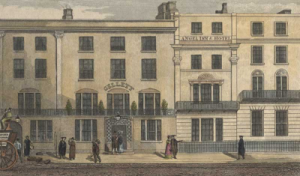
The Angel Hotel Oxford High Street c 1820, Wikipedia
‘Runners’ would go from cafe to cafe to keep patrons up to date with the latest news. As the admission price was so low, anyone could frequent coffee houses, and soon became connected to equality and republicanism, which concerned Charles II so much that banning them was considered in 1675, though due to public outcry, it was withdrawn. The popularity of coffeehouses decreased around the 18th century, as tea became more popular, and the intelligentsia preference changed to exclusive gentlemen’s clubs.
Written and researched by MOX volunteer Iulia Costache.
Want to write your own Oxford-inspired post? Sign up as a volunteer blogger.
References:
Austin, K. (2022, August 23). Jews and the Reformation. obo. https://www.oxfordbibliographies.com/display/document/obo-9780195399301/obo-9780195399301-0492.xml
BBC. (n.d.). Reasons for coming to England – Jewish communities and their expulsion from England in 1290 – OCR B – GCSE history revision – OCR B – BBC bitesize. BBC News. https://www.bbc.co.uk/bitesize/guides/zpbs7hv/revision/1
Edward I (Longshanks) expels the Jews from England. Edward I (Longshanks) Expels the Jews from England : History of Information. (n.d.). https://www.historyofinformation.com/detail.php?id=1901
Brain, J. (n.d.). Edward I. Historic UK. https://www.historic-uk.com/HistoryUK/HistoryofEngland/Edward-I/#:~:text=Edward%20I%2C%20known%20by%20many,III%20and%20Eleanor%20of%20Provence.
Holmes, T. (2011, June 24). Religions – Judaism: Readmission of Jews to Britain in 1656. BBC. https://www.bbc.co.uk/religion/religions/judaism/history/350.shtml#:~:text=Cromwell%20saw%20that%20the%20return,and%20Portugal%20came%20to%20Britain.
Johnson, B. (2015, May 2). English coffeehouses. Historic UK. https://www.historic-uk.com/CultureUK/English-Coffeehouses-Penny-Universities/
Glynne-Jones, J. (2020, June 6). A social blend: The history of the oxford coffeehouse. Cherwell. https://www.cherwell.org/2020/06/06/a-social-blend-the-history-of-the-oxford-coffeehouse/
Gossman, L. (2020, July 15). From Expulsion to Emancipation: Jews in England 1290-1858. The history of jews in Great Britain: The Reformation, Cromwell, the Commonwealth, and readmission of the jews. https://victorianweb.org/religion/judaism/gossman2.html
Miller, Y. A. (2021, December 19). Oxford’s surprising Jewish history. Aish.com. https://aish.com/oxfords-surprising-jewish-history/
Schoenberg, S., & Bard, M. (n.d.). United Kingdom Virtual Jewish History Tour. Jewish Virtual library. https://www.jewishvirtuallibrary.org/united-kingdom-virtual-jewish-history-tour#1
The National Archives. (2022, December 8). Jews in England 1066. The National Archives. https://www.nationalarchives.gov.uk/education/resources/jews-in-england-1066/
Why were the Jews expelled from England in 1290?. Faculty of History. University of Oxford. (n.d.). https://www.history.ox.ac.uk/why-were-the-jews-expelled-from-england-in-1290-0

